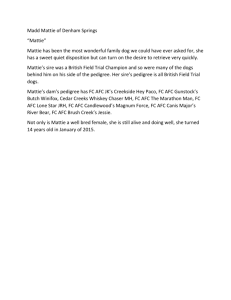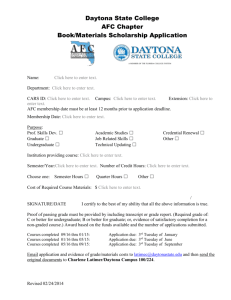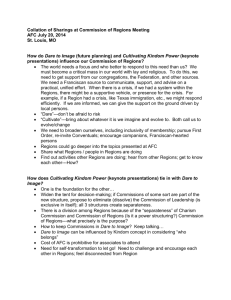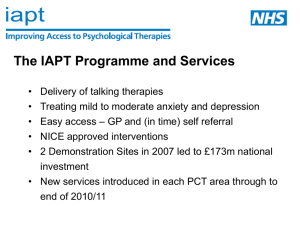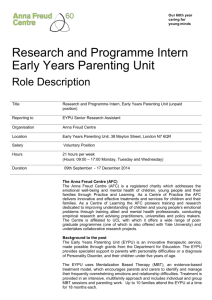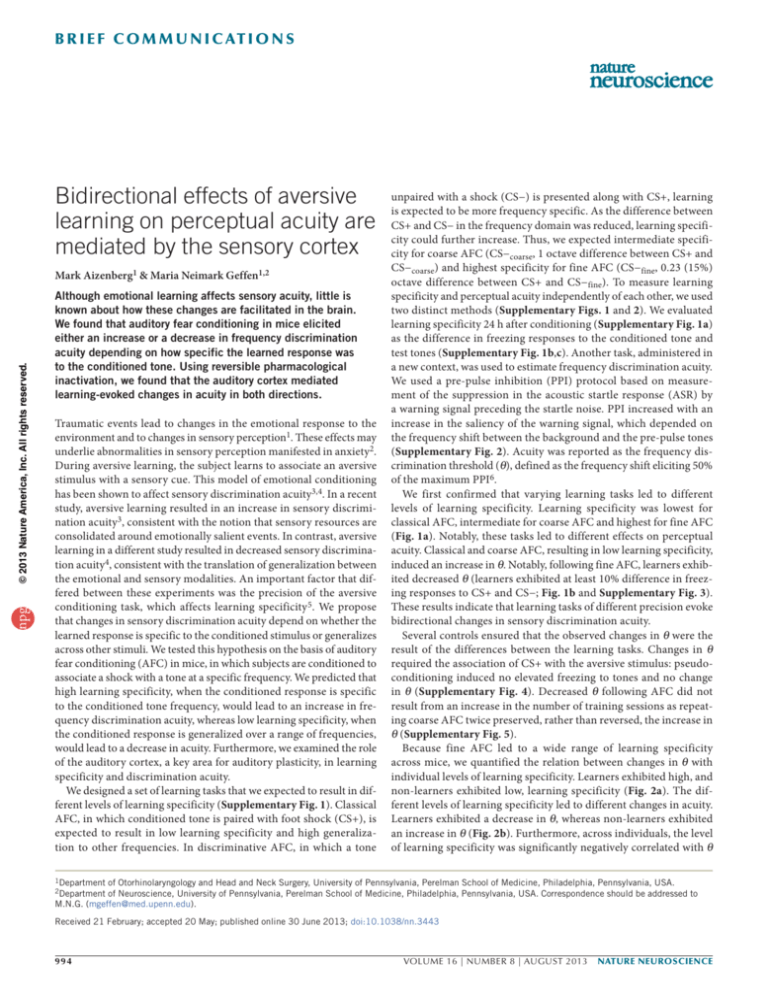
B r i e f c o m m u n i c at i o n s
Bidirectional effects of aversive
learning on perceptual acuity are
mediated by the sensory cortex
npg
© 2013 Nature America, Inc. All rights reserved.
Mark Aizenberg1 & Maria Neimark Geffen1,2
Although emotional learning affects sensory acuity, little is
known about how these changes are facilitated in the brain.
We found that auditory fear conditioning in mice elicited
either an increase or a decrease in frequency discrimination
acuity depending on how specific the learned response was
to the conditioned tone. Using reversible pharmacological
inactivation, we found that the auditory cortex mediated
learning-evoked changes in acuity in both directions.
Traumatic events lead to changes in the emotional response to the
environment and to changes in sensory perception1. These effects may
underlie abnormalities in sensory perception manifested in anxiety2.
During aversive learning, the subject learns to associate an aversive
stimulus with a sensory cue. This model of emotional conditioning
has been shown to affect sensory discrimination acuity3,4. In a recent
study, aversive learning resulted in an increase in sensory discrimination acuity3, consistent with the notion that sensory resources are
consolidated around emotionally salient events. In contrast, aversive
learning in a different study resulted in decreased sensory discrimination acuity4, consistent with the translation of generalization between
the emotional and sensory modalities. An important factor that differed between these experiments was the precision of the aversive
conditioning task, which affects learning specificity 5. We propose
that changes in sensory discrimination acuity depend on whether the
learned response is specific to the conditioned stimulus or generalizes
across other stimuli. We tested this hypothesis on the basis of auditory
fear conditioning (AFC) in mice, in which subjects are conditioned to
associate a shock with a tone at a specific frequency. We predicted that
high learning specificity, when the conditioned response is specific
to the conditioned tone frequency, would lead to an increase in frequency discrimination acuity, whereas low learning specificity, when
the conditioned response is generalized over a range of frequencies,
would lead to a decrease in acuity. Furthermore, we examined the role
of the auditory cortex, a key area for auditory plasticity, in learning
specificity and discrimination acuity.
We designed a set of learning tasks that we expected to result in different levels of learning specificity (Supplementary Fig. 1). Classical
AFC, in which conditioned tone is paired with foot shock (CS+), is
expected to result in low learning specificity and high generalization to other frequencies. In discriminative AFC, in which a tone
unpaired with a shock (CS−) is presented along with CS+, learning
is expected to be more frequency specific. As the difference between
CS+ and CS− in the frequency domain was reduced, learning specificity could further increase. Thus, we expected intermediate specificity for coarse AFC (CS−coarse, 1 octave difference between CS+ and
CS−coarse) and highest specificity for fine AFC (CS−fine, 0.23 (15%)
octave difference between CS+ and CS−fine). To measure learning
specificity and perceptual acuity independently of each other, we used
two distinct methods (Supplementary Figs. 1 and 2). We evaluated
learning specificity 24 h after conditioning (Supplementary Fig. 1a)
as the difference in freezing responses to the conditioned tone and
test tones (Supplementary Fig. 1b,c). Another task, administered in
a new context, was used to estimate frequency discrimination acuity.
We used a pre-pulse inhibition (PPI) protocol based on measurement of the suppression in the acoustic startle response (ASR) by
a warning signal preceding the startle noise. PPI increased with an
increase in the saliency of the warning signal, which depended on
the frequency shift between the background and the pre-pulse tones
(Supplementary Fig. 2). Acuity was reported as the frequency discrimination threshold (θ), defined as the frequency shift eliciting 50%
of the maximum PPI6.
We first confirmed that varying learning tasks led to different
­levels of learning specificity. Learning specificity was lowest for
­classical AFC, intermediate for coarse AFC and highest for fine AFC
(Fig. 1a). Notably, these tasks led to different effects on perceptual
acuity. Classical and coarse AFC, resulting in low learning specificity,
induced an increase in θ. Notably, following fine AFC, learners exhibited decreased θ (learners exhibited at least 10% difference in freezing responses to CS+ and CS−; Fig. 1b and Supplementary Fig. 3).
These results indicate that learning tasks of different precision evoke
bidirectional changes in sensory discrimination acuity.
Several controls ensured that the observed changes in θ were the
result of the differences between the learning tasks. Changes in θ
required the association of CS+ with the aversive stimulus: pseudoconditioning induced no elevated freezing to tones and no change
in θ (Supplementary Fig. 4). Decreased θ following AFC did not
result from an increase in the number of training sessions as repeating coarse AFC twice preserved, rather than reversed, the increase in
θ (Supplementary Fig. 5).
Because fine AFC led to a wide range of learning specificity
across mice, we quantified the relation between changes in θ with
­individual levels of learning specificity. Learners exhibited high, and
non-­learners exhibited low, learning specificity (Fig. 2a). The different levels of learning specificity led to different changes in acuity.
Learners ­exhibited a decrease in θ, whereas non-learners exhibited
an increase in θ (Fig. 2b). Furthermore, across individuals, the level
of learning specificity was significantly negatively correlated with θ
1Department
of Otorhinolaryngology and Head and Neck Surgery, University of Pennsylvania, Perelman School of Medicine, Philadelphia, Pennsylvania, USA.
of Neuroscience, University of Pennsylvania, Perelman School of Medicine, Philadelphia, Pennsylvania, USA. Correspondence should be addressed to
M.N.G. (mgeffen@med.upenn.edu).
2Department
Received 21 February; accepted 20 May; published online 30 June 2013; doi:10.1038/nn.3443
994
VOLUME 16 | NUMBER 8 | AUGUST 2013 nature neuroscience
b r i e f c o m m u n i c at i o n s
b
PPI (%)
a
Classical
Coarse
Fine (learners)
100
50
0
100
400
80
300
60
CS+
tone
40
20
0
� change (%)
Normalized freezing (%)
120
0
4
80
**
8
100
0
B 0
5
10
Tone frequency (kHz)
15
***
–100
Coarse
Fine
(learners)
(Fig. 2c). These results suggest that the effect of learning on sensory
acuity is governed not only by the precision of the learning task, but
also by the individual level of learning specificity.
The auditory cortex is important for learning-induced plastic
changes in acoustic representation7,8. To test the role of auditory
cortex in the observed changes in learning specificity and perceptual
discrimination, we inactivated the auditory cortex by local infusion
of fluorescent muscimol during testing following coarse or fine AFC
(Supplementary Fig. 6a). Muscimol diffusion and its effect on clickevoked local field potentials were restricted to the auditory cortex
(Supplementary Figs. 6b and 7). Infusion of muscimol in the auditory cortex did not induce a change in θ without fear conditioning
(Supplementary Fig. 6c). These results are consistent with classical studies demonstrating that lesions of the auditory cortex do not
impair frequency discrimination acuity9. However, inactivation of
the auditory cortex reversibly abolished the bidirectional effects of
coarse and fine AFC on θ (Fig. 3a and Supplementary Fig. 6d).
Notably, specificity of learning was unchanged during inactivation
(Fig. 3b, Supplementary Fig. 6e). The change in θ after fine AFC
was no longer correlated with learning specificity across individuals
following muscimol injection (Fig. 3c). The expected bidirectional
changes in θ following coarse and fine AFC, as well as the negative
correlation between change in θ and individual learning specificity,
recovered 24 h later (Fig. 3a,c). The effect of muscimol was not
a result of the injection or cannula implantation, as infusing the
fluorescent vehicle instead of muscimol preserved the expected
a
bidirectional changes in θ following fine and coarse AFC (Fig. 3a) and
the negative correlation between change in θ and learning specificity
following fine AFC (Fig. 3c). Furthermore, the effect of muscimol
was not systemic, as infusing muscimol in the somatosensory cortex preserved the expected increase in θ after coarse AFC, as well as
the negative correlation between change in θ and learning specificity
after fine AFC (Supplementary Fig. 8). These results demonstrate
that the auditory cortex mediates both the increase and the decrease
in sensory acuity evoked by fear conditioning without affecting
learning specificity.
We found that the effect of auditory aversive learning on frequency
discrimination is governed by how specific learning is to the conditioned tone. Low learning specificity led to decreased acuity, whereas
high learning specificity led to increased acuity. Moreover, we identified a previously unknown specific role of the auditory cortex in emotional learning: the auditory cortex controls learning-induced changes
in frequency discrimination acuity, but not the specificity of learning.
Although previous studies have found that the amygdala is important
for the generalization or specificity of learned fear10, the effects of
varying learning specificity levels on auditory ­perception have not
previously been measured. Our results demonstrate a dissociation
between the neuronal mechanisms underlying learning specificity and
changes in perceptual acuity and suggest a top-down cortical control
of learning-evoked changes in sensory acuity.
b
c
Normalized PPI (%)
� change (%)
nature neuroscience VOLUME 16 | NUMBER 8 | AUGUST 2013
θ log change
Normalized freezing (%)
Figure 2 Learning specificity following
fine AFC was negatively correlated with
Learners
100
120
the frequency discrimination threshold.
Non-learners
80
(a) Learners exhibited higher learning
80
60
specificity than non-learners by freezing
1
40
40
less to three test tones (top) or CS−fine
R2 = 0.73
CS+
(bottom) than to CS+ (top: each group n = 4,
tone
0
20
repeated-measures ANOVA, between-subject
0
0
4
8
factor: conditioning type, F1,6 = 8.7,
B 0
5
10
15
∆ f/f (%)
0
Tone frequency (kHz)
P = 0.025; bottom: each group n = 10;
learners, t9 = 4.8, P = 0.00096; non***
*
n.s.
200
100
***
learners, t9 = 0.3, P = 0.79; paired t test).
(b) Learners exhibited decreased θ (n = 9,
100
Non-learners
Learners
t8 = 5.4, P = 0.0007), whereas non-learners
–1
50
–10
0
10
20
exhibited increased θ (n = 5, t4 = −3.18,
0
LSI
P = 0.034, paired t test). Top, PPI as a
function of frequency shift after fine AFC
–100
0
Learners Non-learners
CS+ CS–fine CS+ CS–fine
for learners (closed circles) and non-learners
Learners
Non-learners
(open circles). Bottom, θ change for learners
and non-learners. (c) θ was negatively correlated
with learning specificity index (LSI) for all mice trained on fine AFC (Pearson = −0.86, P = 0.00009). LSI was defined as the difference between
freezing to CS+ and CS−fine. The line represents the linear fit.
Freezing (%)
© 2013 Nature America, Inc. All rights reserved.
4
***
200
Classical
npg
4
80
∆ f/f (%)
Figure 1 AFC resulting in low and high learning specificity led to an
increase and a decrease in frequency discrimination threshold (θ),
respectively. (a) Classical (n = 8, green), coarse (n = 8, blue) and fine AFC
(n = 4 learners, red) resulted in low, medium and high learning specificity
(repeated-measures ANOVA, between-subject factor: conditioning type,
F2,17 = 28.8, P = 0.000003). Shown are freezing responses to CS+, three
test tones and baseline (B). (b) θ increased following classical (n = 15,
t14 = −3.6, P = 0.0029) and coarse AFC (n = 16, t15 = −4.1, P = 0.0009),
and decreased following fine AFC in learners (n = 9, t8 = 5.4, P = 0.0007,
paired t test). Top, baseline PPI (open circles) and PPI following AFC
(closed circles) as a function of frequency shift. Dashed horizontal line
indicates 50% of maximum startle suppression used to determine θ.
Each data point represents average across subjects. Bottom, θ change
following classical, coarse and fine AFC in learners. Here and in subsequent
figures, n refers to the number of mice, error bars represent s.e.m., dots in
scatter plots represent datum for an individual subject and horizontal bars
depict average across subjects; *P < 0.05, **P < 0.01, ***P < 0.001;
n.s., not significant (P > 0.05).
30
995
npg
We measured frequency discrimination acuity using a modified
PPI of the acoustic startle reflex task. ASR is mediated largely by
the caudal pontine reticular nucleus, whereas PPI relies on multiple
nuclei in the brainstem11,12. The frequency discrimination threshold, which was measured via PPI before emotional conditioning,
was therefore likely a reflection of auditory responses of neurons in
subcortical areas, such as the inferior colliculus13. The subcortical
brain areas that are involved in PPI receive strong feedback from the
cortex12. Neurons in the inferior colliculus in particular alter their
auditory response properties depending on feedback from the auditory cortex14, and cortico-collicular feedback is involved in learninginduced changes in representation of acoustic features, such as
sound location15. Because neurons in the auditory cortex exhibit
learning-induced changes in representation of acoustic features16,17,
the auditory cortex may modulate the behaviorally measured frequency discrimination threshold via its feedback onto the subcortical
structures, following emotional learning. These changes may be mediated by the interaction of the inputs from the amygdala and the local
cortical circuitry18. Alternatively, the auditory cortex may function
as a relay nucleus for attention-based modulation from the amygdala.
Feedback from the pre-frontal cortex may also be important, controlling the specificity of contextual learning 19. Although our data
indicate the importance of negative emotion, other learning tasks
may obey a similar rule5.
Methods
Methods and any associated references are available in the online
version of the paper.
Note: Any Supplementary Information and Source Data are available in the
online version of the paper.
996
a
� test: fine
� test: coarse
*
n.s.
500
**
Learners
Non-learners
� change (%)
400
n.s.
300
*
**
200
100
0
–100
M
b
24 h
n.s.
* *
M 24 h Veh
Veh
M
24 h Veh
***
***
***
*
Learning specificity test:
fine
Non-learners
n.s. n.s. n.s.
* *
M
24 h
Veh
M
24 h Veh
Learning specificity test:
coarse
Learners
100
50
0
–50
–100
c
1
Muscimol
1
θ log change
Normalized ∆ freezing (%)
Figure 3 Inactivation of the auditory cortex reversibly canceled the effect
of AFC on θ, but did not affect learning specificity. (a) Inactivation of the
auditory cortex by local infusion of muscimol (M) canceled the effect of
AFC on θ (coarse: n = 17, Z = −0.21, P = 0.84; fine learners: n = 8,
t7 = 0.47, P = 0.65; fine non-learners: n = 10, t9 = −1.1, P = 0.62).
This effect was reversed when tested 24 h later (24 h) in the subjects that
retained their learning performance (coarse: n = 17, Z = 2.39, P = 0.034,
Wilcoxon signed test with Bonferroni correction; fine learners: n = 6,
t5 = 3.9, P = 0.022; fine non-learners: n = 6, t5 = −3.2, P = 0.046,
paired t test with Bonferroni correction). Control vehicle-injected subjects
(Veh) tested on days 2 and 6 displayed expected changes in θ (coarse:
n = 13, t12 = −3.3), P = 0.007; fine learners: n = 5, t4 = 3.1, P = 0.036;
fine non-learners: n = 7, t6 = −4.0, P = 0.0072; paired t test with
Bonferroni correction). (b) Inactivation of the auditory cortex before
the test session preserved the specificity of learning manifested by
differential freezing to CS+ and CS− in coarse (left; n = 18, Z = −3.7,
P = 0.0002) and fine AFC (right; learners, n = 8 mice, Z = −2.5,
P = 0.012; non-learners, n = 10, Z = −0.36, P = 0.72, Wilcoxon signed
test). The differential freezing response to CS+ and CS− was preserved
24 h after muscimol infusion (24 h) after coarse AFC (n = 18, Z = −3.6,
P = 0.0003) and after fine AFC (learners: n = 6, Z = −2.2, P = 0.028;
non-learners: n = 6, Z = −1.2, P = 0.25). Vehicle-infused control mice
also exhibited the same pattern of differential freezing response to CS+
and CS− after coarse AFC (n = 14, Z = −3.3, P = 0.001) and after
fine AFC (learners: n = 7, Z = −2.4, P = 0.018; non-learners: n = 7,
Z = −0.51, P = 0.61; Wilcoxon signed test). Two-way ANOVA confirmed
no effect of muscimol treatment (F2,84 = 0.1, P = 0.89) and a significant
reduction of differential freezing in non-learning group (Z2,84 = 36,
P < 0.000001). (c) Correlation between learning specificity index and
change in θ after fine AFC was abolished by muscimol infusion (left;
Pearson correlation = 0.11, P = 0.685), but recovered 24 h later
(bottom, closed circles; Pearson correlation = −0.77, P = 0.006),
and was spared in vehicle-infused mice (bottom open circles;
Pearson correlation = −0.78, P = 0.004).
θ log change
© 2013 Nature America, Inc. All rights reserved.
b r i e f c o m m u n i c at i o n s
0
M
Control
2
R = 0.59
0
20
LSI
40
24 h
Veh
0
R2 = 0.01
–1
–20
24 h Veh
–1
–20
R 2 = 0.55
0
20
40
LSI
Acknowledgments
We thank L. Mwilambwe-Tshilobo, D. Mohabir, A. Nguyen and L. Liu for technical
assistance. M.N.G. is the recipient of the Burroughs Wellcome Fund Career Award
at the Scientific Interface. The work was supported by the Klingenstein Award
in Neuroscience, the Pennsylvania Lions Club Hearing Fellowship and the Penn
Medicine Neuroscience Center Pilot grant to M.N.G.
AUTHOR CONTRIBUTIONS
M.A. and M.N.G. designed the experiments, analyzed the data, prepared the
figures and wrote the manuscript. M.A. carried out the experiments.
COMPETING FINANCIAL INTERESTS
The authors declare no competing financial interests.
Reprints and permissions information is available online at http://www.nature.com/
reprints/index.html.
1. Asutay, E. & Vastfjall, D. PLoS ONE 7, e38660 (2012).
2. Krusemark, E.A. & Li, W. Chemosens. Percept. 5, 37–45 (2012).
3. Li, W., Howard, J., Parrish, T. & Gottfried, J. Science 319, 1842–1845
(2008).
4. Resnik, J., Sobel, N. & Paz, R. Nat. Neurosci. 14, 791–796 (2011).
5. Chapuis, J. & Wilson, D. Nat. Neurosci. 15, 155–161 (2011).
6. Clause, A., Nguyen, T. & Kandler, K. J. Neurosci. Methods 200, 63–67 (2011).
7. Weinberger, N.M. Nat. Rev. Neurosci. 5, 279–290 (2004).
8. Froemke, R.C. & Martins, A. Hear. Res. 279, 149–161 (2011).
9. Butler, R.A., Diamond, I.T. & Neff, W.D. J. Neurophysiol. 20, 108–120 (1957).
10.Shaban, H. et al. Nat. Neurosci. 9, 1028–1035 (2006).
11.Koch, M. & Schnitzler, H.U. Behav. Brain Res. 89, 35–49 (1997).
12.Li, L., Du, Y., Li, N., Wu, X. & Wu, Y. Neurosci. Biobehav. Rev. 33, 1157–1167
(2009).
13.Basavaraj, S. & Yan, J. PLoS ONE 7, e45123 (2012).
14.Suga, N. Neurosci. Biobehav. Rev. 36, 969–988 (2012).
15.Bajo, V.M., Nodal, F.R., Moore, D.R. & King, A.J. Nat. Neurosci. 13, 253–260 (2010).
16.Dahmen, J.C., Hartley, D.E. & King, A.J. J. Neurosci. 28, 13629–13639 (2008).
17.Fritz, J.B., David, S.V., Radtke-Schuller, S., Yin, P. & Shamma, S.A. Nat. Neurosci.
13, 1011–1019 (2010).
18.Pape, H.C. & Pare, D. Physiol. Rev. 90, 419–463 (2010).
19.Xu, W. & Sudhof, T.C. Science 339, 1290–1295 (2013).
VOLUME 16 | NUMBER 8 | AUGUST 2013 nature neuroscience
ONLINE METHODS
Animals. All experiments were performed in adult male mice (C57BL/6J, n = 100,
12–15 weeks of age, 22–32 g), housed with at most five mice to a cage, at 28 °C on
a 12-h light:dark cycle with water and food provided ad libitum. All experiments
were performed during the animals’ dark cycle. All experimental procedures were
in accordance with NIH guidelines and approved by the Institutional Animal
Care and Use Committee at the University of Pennsylvania. Simple randomization was used to assign the subjects to the experimental groups. Blinding was
not possible as animals in different groups underwent different experimental
protocols and analysis.
npg
© 2013 Nature America, Inc. All rights reserved.
Surgery. Mice were anesthetized under isoflurane (1.5–2%, vol/vol). A small
craniotomy was performed over the target stereotaxic coordinates relative to
bregma, −2.6 mm anterior, ±4 mm lateral, +2 mm ventral. Custom-cut guide
cannulas (Plastics One) were lowered in the brain and secured to the skull
using dental cement (C&B Metabond) and acrylic (Lang Dental). For post­operative analgesia, Buprenex (0.1 mg per kg of body weight) was injected intraperitonially and lidocaine was applied topically to the surgical site. An antibiotic
(0.3% wt/vol gentamicin sulfate) was applied daily (for 7 d) to the surgical site
during recovery.
Cannula infusions. Mice were sedated by isoflurane (1%). 0.4 µl of 0.8 mM
muscimol conjugated with the Bodipy TMR-X fluorophore or Bodipy TMR-X
alone (Vehicle) (Life Technologies)20 dissolved in phosphate-buffered saline was
infused bilaterally via a thin internal cannula inserted in the implanted guide
(Plastics One).
Histology. Images of coronal sections (50 µm) of fixed brain tissue were digitally
acquired using a fluorescent microscope (Olympus) equipped with Texas Red
filters (Chroma). To visualize the spread of muscimol, images from different
mice (N = 18) were manually aligned along the brain contours, and automatically superimposed by averaging the intensity values of each pixel on the red
channel (Matlab).
Experimental setup. During AFC, the mouse was placed in a conditioning
cage with a shock floor (Coulbourn) inside a sound attenuation cubicle (Med
Associates) housed inside a single-walled acoustic chamber (Industrial acoustics). During learning specificity tests, a custom-made test cage of similar size
but different floor and wall pattern and color was used. Auditory stimuli were
provided by a free-field magnetic speaker (Tucker-Davis Technologies). Electric
shock (0.5 mA, 0.5 s) was delivered by a precision animal shocker (Coulbourn).
Freezeframe-3 software (Coulbourn) was used for stimulus control and analysis
of animal behavior. During the PPI procedure, the mouse was placed in a custommade tube on the sensor plate (San Diego Instruments). The speaker, housing,
platform and webcam (Logitech) were placed in the sound attenuation cubicle
(Med Associates) housed inside a single-walled acoustic chamber. The speaker
was positioned above the mouse. The sound delivery apparatus was calibrated
using a 1/8-inch condenser microphone (Brüel & Kjær) positioned at the expected
location of the mouse’s ear, to deliver each stimulus at 70 dB sound pressure
level (SPL) relative to 20 µPa. All pure tones presented during training and test
sessions were at 70 dB SPL.
Behavioral timeline for non-cannulated mice (Supplementary Fig. 1a). Mice
were habituated for three consecutive days to AFC cage for 15–20 min in silence
and to the frequency discrimination acuity apparatus for 15–20 min, during which
they were exposed to a constant tone at 15 kHz. They underwent the frequency
discrimination acuity test on the following day. Following frequency discrimination acuity test, one group of mice was subjected to classical AFC (Supplementary
Fig. 1a). These mice underwent the learning specificity test 1 d later. Another
group of mice was subjected to coarse and fine AFC (Supplementary Fig. 1a).
Following frequency discrimination acuity test, mice underwent coarse AFC. The
mice underwent the learning specificity test and the frequency discrimination
acuity test 1 d later. The mice underwent fine AFC 3 d after that, followed by the
learning specificity test and the frequency discrimination acuity test 1 d later.
Behavioral timeline for cannulated mice (Supplementary Fig. 6a). Mice were
implanted with cannulas and allowed to recover for 7 d. During this time, they
doi:10.1038/nn.3443
were habituated to the AFC cage and frequency discrimination acuity apparatus as described above. The timeline of experiments was the same as for noncannulated mice, except that the learning specificity and frequency discrimination tests were repeated 1 and 2 d following each AFC session. Muscimol or
vehicle was infused in the auditory cortex or muscimol was infused in the somato­
sensory cortex (Supplementary Fig. 8) via the implanted cannula one day after
each AFC session, at least 1 h before the first set of tests. Inactivation of the cortex
by muscimol was expected to start immediately and to end after 24 h (before
the second set of tests)20,21. Different groups of mice were used for infusion of
muscimol in the auditory cortex, vehicle in the auditory cortex and muscimol in
the somatosensory cortex.
Fear conditioning (Supplementary Fig. 1b). During classical AFC, following
5 min of silence, ten tones (15.0 kHz) co-terminated with a foot shock (CS+)
were presented at inter-trial intervals that were randomly varied between 2 and
6 min. During coarse discriminative AFC, following 5 min of silence, ten CS+
(15.0 kHz) co-terminated with foot shock, and ten tones at 7.5 kHz, not paired
with foot shock (CS−coarse), were presented in pseudo-random order with 2-min
inter-stimulus intervals (ISIs). During fine AFC, following 5 min of silence, ten
CS+ tones and ten CS−fine tones (12.75 kHz) were presented in a pseudo-random
order with 2-min ISI. During pseudo-conditioning, the timing of the shock was
pseudo-randomized with respect to the timing of the tones.
Learning specificity test (Supplementary Fig. 1c). For one subset of mice, following classical, coarse and fine AFC, the learning specificity test consisted of
two tones, CS+ and either CS−coarse, CS−coarse or CS−fine, respectively, presented
sequentially at 5-min ISIs. The LSI was defined by difference in the freezing
response to CS+ and CS−. Mice, for which freezing to CS− was lower by more
than 10% relative to CS+, were defined as learners. Otherwise, they were defined
as non-learners. For another subset of mice, the learning specificity test consisted
of CS+ and three test tones (3.75, 7.5 and 12.75 kHz), presented at 3-min ISIs
(Supplementary Fig. 1c). Learning specificity was assayed as the differential
freezing response to CS+ and test tones. To directly compare learning specificity
across fine and coarse learning groups, we introduced an LS90 index, defined as
the estimated frequency at which freezing response to CS− was 10% lower than
the response to CS+ (Supplementary Fig. 9). The LS90 index was strongly correlated with LSI for both coarse and fine AFC. Thus, we used LSI when appropriate
to assay learning specificity, which was critical for the pharmacological experiments that required a tight timeframe for behavioral testing following injection of
the drug.
During conditioning and test sessions, freezing responses were video recorded
and analyzed offline using FreezeFrame software. Freezing responses were
judged as complete immobility of the mouse for at least 1 s. All tones were
20.5 s long. Average freezing response during 20 s before the test tones was
recorded as baseline, while freezing response during the test tones was recorded
as the conditioned response.
Frequency discrimination acuity test (Supplementary Fig. 2). The measurement of frequency discrimination acuity used a modified PPI of the startle reflex
protocol as previously described6. The test measured the magnitude of the ASR
to the startle stimulus as a function of the difference in frequency between the
background tone and the pre-pulse tone (PPS), which immediately preceded
startle stimulus.
The frequency of the background tone was 15.0 kHz. The background tone
was presented continuously between the end of startle stimulus and the start
of PPS. The transition between the background tone and PPS included 1-ms
ramp to avoid clicks. Five frequencies were used for PPS (13.8, 14.7, 14.85,
14.925 and 15.0 kHz). Thus, PPS differed from the background tone by 0, 0.5,
1, 2 and 8%. PPS was 80 ms long and was presented right before the startle
stimulus. The startle stimulus was broad-band noise, presented at 120 dB SPL
relative to 20 µPa for 20 ms. The stimuli were calibrated with respect to the frequency sensitivity of the loudspeaker. To verify that perceptual loudness of the
tones was similar across the frequency range, PPI of the acoustic startle reflex
elicited by the individual tones at each of the five frequencies was measured
(Supplementary Fig. 10).
Each test session consisted of nine startle-only trials, followed by at least
75 pre-pulse trials, followed by one additional startle-only trial. On startle-only
nature neuroscience
trials, background tone was followed directly by startle stimulus. On pre-pulse
trials, each PPS was presented in pseudo-random order with inter-trial ­interval
varying randomly between 15 and 25 s. Negative frequency changes were used
because rodents were previously shown to be more sensitive to downward frequency shifts6.
The magnitude of ASR was measured using sensor plate (San Diego
Instruments) and defined as the maximum vertical force applied in the 500-ms
window following startle stimulus minus average baseline activity during the
500-ms period before startle stimulus. In each PPI session, 50% of the strongest
ASRs for each frequency were averaged and used to calculate PPI
PPI(%) = 100 ⋅
ASR noPPS − ASR PPS
ASR noPPS
a
a
PPI = − +
2 1 + exp (b + c∆f )
In a standard PPI session, 15 repetitions of each PPS were presented (75 trials
in total). However, if either θ was out of the range (0.4–8%) or the fit coefficient
of the curve (R2) was below 0.7, the subject underwent ten more repetitions
(50 trials). If θ and fit curve failed to meet the above criteria after 175 trials,
the subject was excluded from statistical analysis.
Statistical analysis. Because most experiments consisted of within-subject
repetitions, the data (unless otherwise indicated) were analyzed by either twotailed paired t test or repeated-measures ANOVA using SPSS Statistics (IBM).
Samples that did not pass Shapiro-Wilk test for normality were compared using
Wilcoxon signed rank test. Whenever independent samples were compared
using parametric methods, equality of variances was confirmed by Levene’s test.
Multiple comparisons were adjusted by Bonferroni correction.
20.Allen, T.A. et al. J. Neurosci. Methods 171, 30–38 (2008).
21.Krupa, D.J., Ghazanfar, A. & Nicolelis, M. Proc. Natl. Acad. Sci. USA 96,
8200–8205 (1999).
22.Talwar, S.K., Musial, P. & Gerstein, G. J. Neurophysiol. 85, 2350–2358
(2001).
npg
© 2013 Nature America, Inc. All rights reserved.
where ASRnoPPS is the response when PPS frequency is equal to the frequency
of the background tone (15 kHz) and ASRPPS is the response after frequency
shift has occurred.
The frequency discrimination threshold (θ) was defined as a frequency shift
(∆f) that caused 50% inhibition of the maximum ASR. θ is determined from a
parametric fit to a generalized logistic function
Local field potential recordings (Supplementary Fig. 7). Mice (n = 2) were
anesthetized with isoflurane (0.6–0.8%) and a craniotomy (2 × 2 mm) was
­performed over the auditory cortex, followed by a localized durotomy targeted to electrode tips. A silicone multi-electrode probe (four shanks, 200-µm
inter-shank distance, two diamonds of four electrodes on each shank, 150-µm
­vertical inter-diamond distance, impedance ~500 kΩ, Neuronexus) was lowered
to 900 µm vertically. The stimulus consisted of six clicks presented at 10 Hz,
­followed by 500 ms of silence. Local field potentials (LFPs) from 32 electrodes
were recorded during presentation of 100 repeats of the stimulus (Neuralynx)22.
Each waveform was filtered between 1 and 300 Hz. A cannula was lowered
targeted to 3.3 mm posterior and 4.3 mm lateral of bregma. This location was
200 µm posterior of the most posterior shank in mouse 1, and 400 µm posterior
of the most posterior shank in mouse 2. 0.5 µl of 0.8 mM muscimol conjugated
with the Bodipy TMR-X fluorophore was injected via syringe infusion pump
(Harvard Apparatus). The LFPs were continuously monitored and saline was
applied over the craniotomy as needed. LFPs in response to 100 repeats of the
stimulus were recorded 1 h later.
nature neuroscience
doi:10.1038/nn.3443



